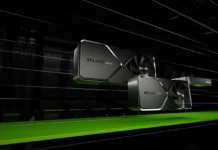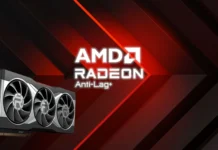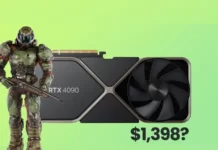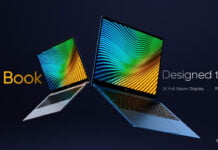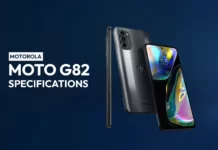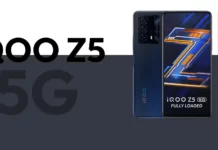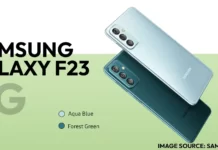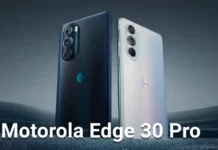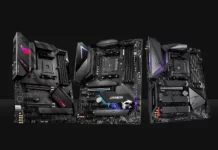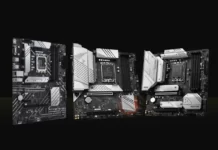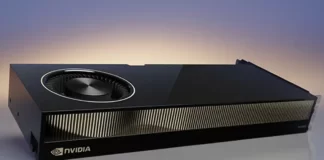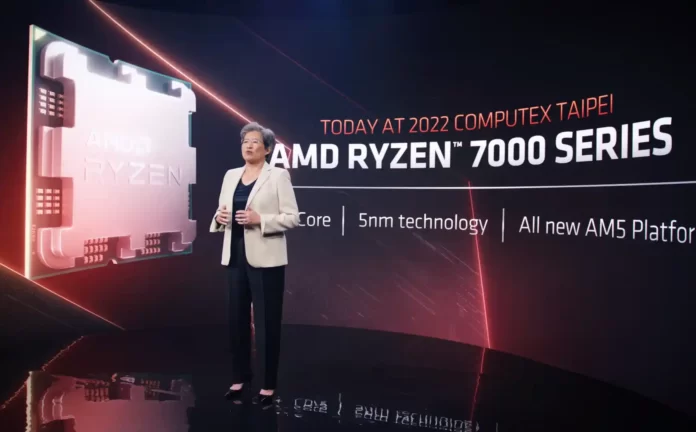
In the recent episode of PC World’s ‘The Full Nerd’ webcast series, visitors Robert Hallock (AMD Director of Technical Marketing), and Frank Azor (Chief Architect of Gaming Solutions), has solved numerous questions and has given further information related to the Ryzen 7000 Desktop CPUs and the look we will see on the AM5 platform.
AMD Details Ryzen 7000 CPUs (Desktop) & AM5 Motherboard Platform Features-
The answer given by both Robert and Frank included many questions from users, and both performed a splendid job of giving answers number of people over at PC World. We have gathered more information on the AMD Ryzen 7000 CPU and AM5 platform showcased since Computex 2022. Now it’s time to reveal all the latest information. Let’s see-

Some of the detail that has been discussed in the interview such as-
- AMD Ryzen 7000 is 125W TDP / 170W Package Power
- AMD Ryzen 7000 5.5 GHz Demo Was In Stock-Spec
- AMD Ryzen 7000 Double L2 Cache is IPC-Benefit
- AMD Ryzen 7000 CPUs Have 28 PCIe Gen 5 lanes
- 1:1 Infinity Fabric Clock (No Frequencies Mentioned)
- B650 Motherboards will support overclocking
- Integrated RDNA 2 GPU supports both Video encoding and decoding
- Integrated RDNA 2 GPU For Commercial/Diagnostic Purposes
- Smart Access Storage Details
AMD Ryzen 7000 CPU has 125W TDP & 170W Package Power for AM5 Socket-
Immediately, the thermal dissipation power records for AMD Ryzen 7000 CPUs will be 125W, while the Package Power Tracking will be 170W.AMD offers this information in reply to whether the 170W data was a genuine TDP for the imminent chips or an upper-bound perimeter for the package.
According to AMD, it enhances around 28W over the AM4 enclose power limit of 142W, while the CPUs had a TDP of 105W. As per AMD, motherboard producers will now be able to organize more premium power characters on their motherboards, which permits better overclocking prospects for devotees and overclockers.
Additionally, Robert verified that the AMD Ryzen 7000 CPUs record 28 PCIe Gen 5 lanes, verifying our prior leaks. The main thing is that out of those 28 lanes, only 24 are functional by the separate GPU and M.2 storage devices since the remains of the four ways are allied to the 600 series PCH. As for the chipsets themselves, Robert also verified that B650 motherboards would completely support overclocking like their B*50-class precursors.
So what we want to clarify is that it’s a 170 Watt socket power which with AMD, that spec is PPT (Package Power) for us. That doesn’t mean that every CPU is going to go up to 170 Watts but it’s 30 (Watt) higher than the socket AM4 power cap which was a 142 (watts). And we did this to mainly improve multi-thread performance as many of the core count chips were actually held back in overall compute performance by relatively modest socket power.
The other point that I want to make is that by raising the minimum required socket power or minimum spec, you also raise the power delivery with every motherboard built to that spec so you get more robust power characteristics on all the boards which we are pretty excited about as well, It should be good for people who want to experiment with overclocking, people who appreciate premium board designs.
Robert Hallock (AMD Director of Technical Marketing)
AMD Ryzen 7000 5.5 GHz CPU Demo Was pure on Stock Spec, with no Overclocking or High-End Components Used
For the 5.5 GHz clock speed gaming display, Robert again assured us that the frequencies were completely on stock spec. The motherboard used was an orientation X670 blueprint, and the cooling was a normal ASETEK 280mm AIO cooler. It is also evident that no overclocking was concerned since the clocks diverse between 5.1 to 5.5 GHz.
AMD presents some outrageously speedy frequencies with the same Ryzen 7000 CPU sample striking up to 5.52 GHz. Still, we have analyzed some differences in the clock speeds, which started at 5.1 GHz and went up to the maximum 5.52 GHz speed discussed by everyone. Surprisingly, Robert declares that they analyzed most of the threads regulating up to 5.5 GHz in the individual game display. The 16-core Ryzen 7000 trial product was manufactured roughly late April or early May. So, AMD might still compress more headroom out of this chip if users want to or allow overclockers to do the job.

But Ian Cutress from TechTechPotato put all AMD claims on this demo in a single tweet:
AMD Ryzen 7000 16-Core Pre-Production Sample’ Gaming’ Clocks-
*The video starts at where Dr. Lisa Su shows AMD Ryzen 7000 Series CPU 5.5 GHz clock speed
We used a 280mm (ASETEK) watercooler so nothing exotic it’s just a dual 140 loop that you can buy from Amazon or Newegg. It was running an AMD reference motherboard so one of our internal AM5 socket motherboards, a 16 core prototype part built in late April or early May and we just plugged it in and ran it. It was not an overclocked part, its just the natural frequency of that particular prototype.
So in the game, we were running most of the threads around 5.5 (GHz), it depends on the game load, depends on the scene, of course, clock speed fluctuates up and down so somewhere between 5.2 and 5.5 is pretty common on all the threads playing that game. So I wanna reassure people that this was nothing exotic in terms of cooling and nothing exotic in terms of parts selection or config or overclocking. It is exactly what you see, you plug in a Ryzen 7000 series part and play the game, & that’s the frequency!
Robert Hallock (AMD Director of Technical Marketing)
AMD Ryzen 7000 Doubles the L2 Cache & can achieve a 1:1 Infinity Fabric Clock
Robert also discussed how doubling the L2 supply can help enhance IPC-related core performance. The L2 supply did not improve noticeably since more L2 supply results come out that it hits still; it also means poor latency and dies sizes receiving superior that goes to include in the cost. So, AMD created a view where the L2 supply is enlarged sufficiently to insert the performance profits of the Ryzen 7000 Desktop CPUs.
On receiving inquiries if the new AM5 platform will run DDR5 memory at a 1:1 ratio with the perpetuity Fabric, Robert answered ‘Yes’ but did not state at what frequencies it would be run at the maximum point. Here is another matter of discussion when we will acquire nearer to the official launch of the Ryzen 7000 Desktop CPUs on the AM5 motherboards.
So L2 cache, we did double it in Zen 4, it is an IPC benefit, it helps the core contain internally more information, overall it improves throughput and so it will be beneficial to multiple categories of workloads, be it integers like gaming or more floating-point like stuff like scientific and creative workloads.
Robert Hallock (AMD Director of Technical Marketing)
AMD Ryzen 7000 RDNA 2 iGPUs: APUs still happening for Desktops! & Video Encode/Decode
What did the new RDNA 2 iGPUs on the Ryzen 7000 Desktop CPUs carry to the table? AMD mentioned that with incorporated graphics on their complete CPU portfolio, they could increase their business into the commercial division, which makes a lot of intellect since a lot of patrons. There is no need for an individual graphics card, and one desires something as easy as plug-and-play.
Another matter is that, unlike AMD’s Navi 24 GPUs, the Ryzen 7000 iGPU based on the equal RDNA 2 core design will come with a VCN engine that favors both AV1 Video Encode and Decode.

Users with graphics cards can debug if their graphics card is faulty or not or for other purposes because for DIY builders, the RDNA 2 iGPU can provide troubleshooting and diagnostic capabilities. The same can be used for users who don’t have graphics cards or those waiting on one who can’t turn on their PC until they get their discrete GPU.
Frank Azor took the subject to a more enjoyable space by commenting that while AMD Ryzen 7000 CPUs will include ‘little graphics’ cores compared to the ‘bigger graphics’ cores on APUs, they will even host some of the Smart Eco technologies boasted by notebooks. AMD’s RDNA 2 iGPUs can allow for sub-50W power usage in idle mode, Smart Shift on Desktop CPUs with RDNA 2 iGPUs can swap from discrete GPU to integrated GPU for light workloads and deliver sub-5W power or even mW power.
Another matter is that, unlike AMD’s Navi 24 GPUs, the Ryzen 7000 iGPU based on the equal RDNA 2 core design will come with a VCN engine that favors both AV1 Video Encode and Decode.
We still think of the Ryzen 7000 series as a CPU. The graphics cores in that IO die are not many, the purpose of adding graphics is three-fold. One, it greatly expands these products in the commercial market where they don’t buy discrete at all, they just want to turn it on, have video encode/decode and light up some displays for office work and that’s what the GPU in the IO die will offer so that’s a huge business opportunity for us on the Ryzen PRO side as we start migrating these components over to that business.
The second is for diagnostic purposes, how do you know that you have a bad graphics card? Well, you have to swap in another graphics card but with the graphics core we have, you can do a little bit of troubleshooting thirdly, we were thinking about users who are planning to buy a discrete graphics, and it’s still in transit in the mail but all the other hardware has arrived first so it’s all sat there, looking at a pile of components and don’t have a GPU to actually set that all up. That would go away with the Ryzen 7000 series.
We are still going to do APUs with big graphics so APUs ‘BIG GRAPHICS’, CPUs ‘little graphics’. That would be our strategy going forward.
Robert Hallock (AMD Director of Technical Marketing)
We are developing a lot of technologies that make use of integrated graphics in many ways and there are things that we are able to do with technologies such as Smart Shift ECO where we can turn off the discrete graphics and we can run the notebook off of the iGPU and say you want that because you want less heat, longer battery life (even when you are playing a game) or you want less fan noise or lower power consumption, there’s all these benefits to it. Because we have that thin integrated graphics in Ryzen 7000 series, it’s going to allow us to bring more of these types of smart technologies over to the desktops aswell so those customers can get some of these benefits.
Frank Azor (Chief Architect of Gaming Solutions)
As for whether we will see a variant of Ryzen 7000 Desktop CPUs which has iGPU disabled, Robert did state that all Zen 4 chips will have integrated RDNA 2 graphics so those in hopes of seeing a ‘KF-esque’ variant should be a bit unhappy.
SAS is The Shortcut!: AMD Smart Access Storage vs Direct Storage? They are the same thing
AMD commenced its technology recognized as Smart Access Storage SAS moving forward to the Direct Storage side. Users are confused, but it is a substitute for Direct Storage. In reality, SAS is based on the same algorithms and APIs as Direct Storage and permits the NVMe SSD to straight converse with separate graphics.
I have seen Smart Access Storage in action and it works pretty well! The primary difference between Direct Storage and Smart Access Storage is that, think of, first of all, Smart Access Storage uses Direct Storage so that’s really important to know. It’s not a replacement for it is something that we built that takes advantage of Direct Storage, it uses the compression algorithms and APIs that Direct Storage promotes, supports, and endorses and asks ISVs to design so it’s fully compatible with them.
What we do a little differently with Smart Access Storage is that because we own an entire platform from an architecture perspective, end to end, from CPU to all the way to storage subsystem to all the way to graphics, that allows us to create more efficient streamlines between the game content and GPU itself. We can avoid some parts of the PC subsystem in order to reduce latency and increase performance to reduce bottlenecks when it comes to decompressing game assets and streaming game assets on the GPU.
Smart Access Storage is more of a ubiquitous solution that has to work across a lot of different combinations of hardware that are out there and those combinations may include mixed configurations, let’s say AMD’s CPU and somebody else’s graphics card. and that’s getting more and more complex, you are gonna have three graphics card partners, you have two CPU partners, that may even get more complex, so because it’s more of a hiding compatible ubiquitous solution, there’s more overhead built in order for it to be compatible so there are more CPU calls than more system memory that it has to do in order for it to work so there’s more decompression and management that is done in the CPU versus in our solution, it’s a direct pipe from NVMe to the GPU with those bottlenecks and overheads removed.
We have designed Smart Access Storage to be as open as possible from a compatibility perspective so that’s why we are using Direct Storage we are going to work with Direct Storage titles and we are going to optimize to work with Direct Storage. We don’t have any intention of developing our own algorithm or API since we don’t want to create a walled garden or another walled garden in the industry, so ideally what we would like to have to happen and this is how we designed Smart Access Storage is that you have a Direct Storage compatible game and you have an all AMD desktop or laptop, we’ll have a foundational infrastructure in place so that so we can avoid those routes that add latency and some of those bottlenecks because of compatibility and we kinda short cut and allow the NVMe to direct send data over to the GPU for decompression. So that’s our architecture and our approach is fully compatible but when we can take a shortcut because we have the end-to-end platform, we are gonna enable that shortcut to be taken.
Frank Azor (Chief Architect of Gaming Solutions)
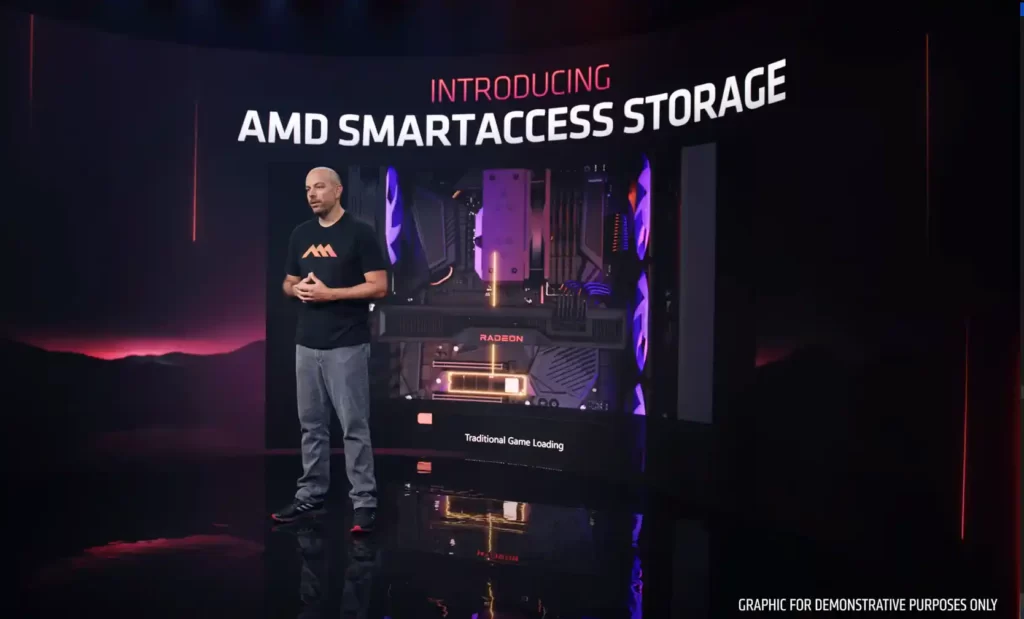
Frank Azor also tells that not all Gen 4 and Gen 5 SSDs will be compliant with Smart Access Storage, there will be a list of SSDs and components that specifically meet their SAS requirements which AMD Ryzen 7000 CPUs and the AM5 platform will support with SAS:
We have an authorized vendor list of parts that we are developing right now with NVME drives and controllers that are meeting our performance requirements around Smart Access Storage. Just because you have a PCIe Gen 4 or the upcoming Gen 5 drive, it doesn’t mean that those drives are going to be able to keep up with the performance demands and capabilities of Smart Access Storage so something folks should understand is that today a lot of the reason why your NVMe drive isn’t able to fully capitalize on its theoretical performance capability is that there are bottlenecks in the data fabric and those bottlenecks exist in different parts of the PC so that often affects your theoretical versus real performance.
What will happen with Smart Access Storage is that once you remove all those paths from point A to point Z that are your obstacles (bottlenecks), suddenly, your NVMe drive will become the bottleneck because the dGPU can receive the data extremely fast but if your NVMe drive was designed from the get-go counting on these bottlenecks along the data path, then you knew you didn’t put much performance on it because you knew it was going to get wasted. You may have used a slower controller or not used the most premium parts or not optimized your product for the highest theoretical limit that it can reach.
Frank Azor (Chief Architect of Gaming Solutions)
At the time of its launch, the AMD Ryzen 7000 Desktop CPUs are supposed to initiate this fall, which means the most basic thing is that we will notice the chips in action in September 2022.
AMD Mainstream Desktop CPU Generations Comparison:
| AMD CPU FAMILY | CODENAME | PROCESSOR PROCESS | PROCESSORS CORES/THREADS (MAX) | TDPS (MAX) | PLATFORM | PLATFORM CHIPSET | MEMORY SUPPORT | PCI-E SUPPORT | LAUNCH |
|---|---|---|---|---|---|---|---|---|---|
| Ryzen 1000 | Summit Ridge | 14nm (Zen 1) | 8/16 | 95W | AM4 | 300-Series | DDR4-2677 | Gen 3.0 | 2017 |
| Ryzen 2000 | Pinnacle Ridge | 12nm (Zen +) | 8/16 | 105W | AM4 | 400-Series | DDR4-2933 | Gen 3.0 | 2018 |
| Ryzen 3000 | Matisse | 7nm (Zen 2) | 16/32 | 105W | AM4 | 500-Series | DDR4-3200 | Gen 4.0 | 2019 |
| Ryzen 5000 | Vermeer | 7nm (Zen 3) | 16/32 | 105W | AM4 | 500-Series | DDR4-3200 | Gen 4.0 | 2020 |
| Ryzen 5000 3D | Warhol? | 7nm (Zen 3D) | 8/16 | 105W | AM4 | 500-Series | DDR4-3200 | Gen 4.0 | 2022 |
| Ryzen 7000 | Raphael | 5nm (Zen 4) | 16/32 | 170W | AM5 | 600-Series | DDR5-5200/5600? | Gen 5.0 | 2022 |
| Ryzen 7000 3D | Raphael | 5nm (Zen 4) | 16/32? | 105-170W | AM5 | 600-Series | DDR5-5200/5600? | Gen 5.0 | 2023 |
| Ryzen 8000 | Granite Ridge | 3nm (Zen 5)? | TBA | TBA | AM5 | 700-Series? | DDR5-5600+ | Gen 5.0 | 2024-2025? |
New Source: AMD Youtube, wccftech, videocardz
Check out more:
- Top 5 best wireless gaming keyboards in 2022
- Top 5 gaming laptops in 2022
- Top 5 PC Cabinets in 2022
- Top 5 PCIe 4.0 SSD for gaming in 2022
- Top 5 AMD Motherboards in 2022
- Best 5 gaming headsets in 2022
- Top 5 Gaming CPUs in 2022: First Quarter of 2022
- Top 5 Best gaming monitors in 2022
- Top 5 best power supplies for gaming in 2022
- Top 5 Best Graphics Cards for Gaming in 2022
- Top 5 best gaming PC in 2022
- Top 5 Best Intel B660 Motherboards in 2022
- Top 5 Best lightweight gaming mouse in 2022
- The top 5 best FreeSync monitors in 2022

